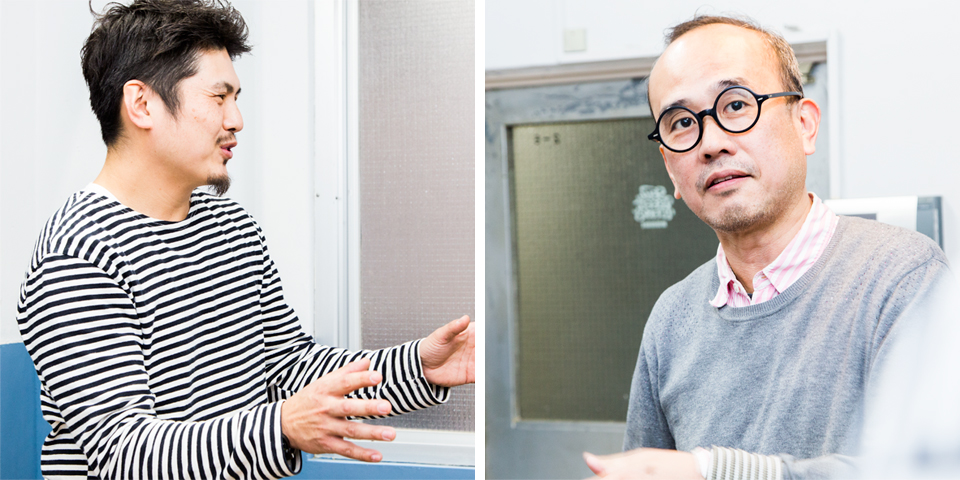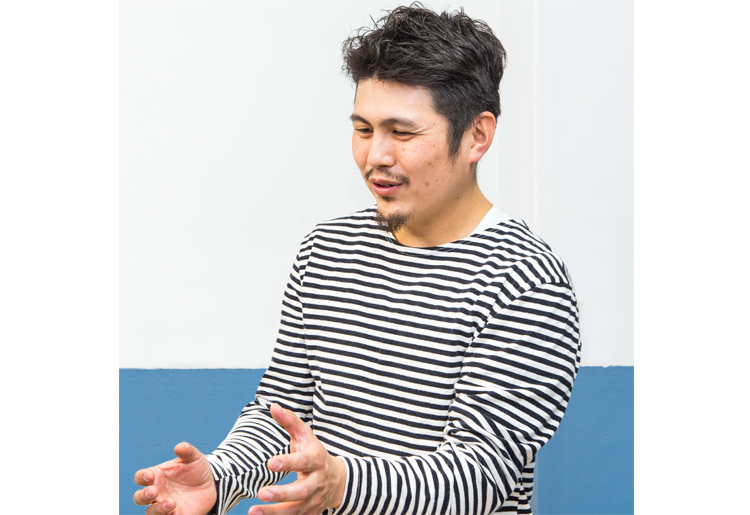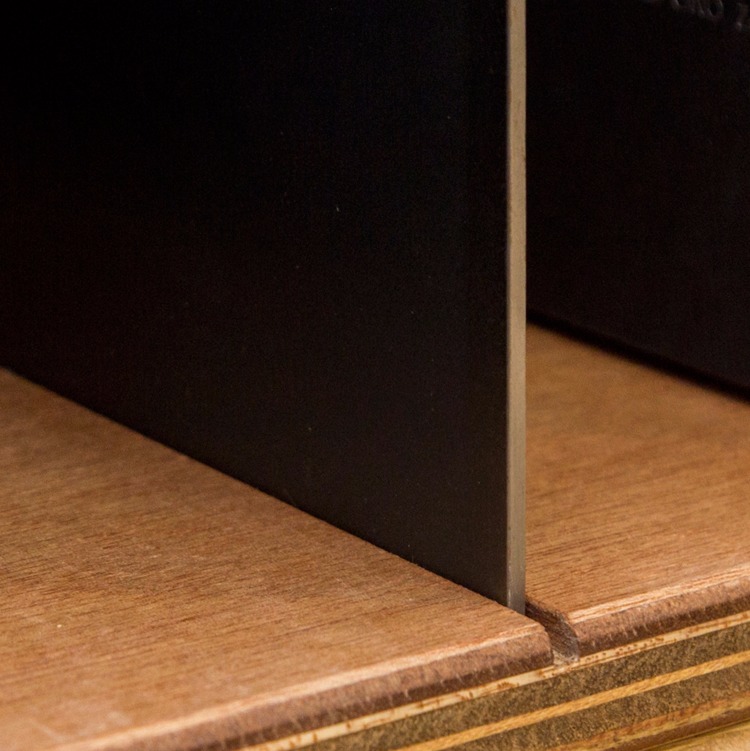A design professional (and record collector) talks about the appeal of <Type>'s record shelf and <THORENS>'s record player.
In recent years, analog records have been attracting more and more attention and the number of releases is increasing. You can choose the records you like, but what criteria should you use when choosing the furniture and record player to store them? We asked Kyo Kobayashi, co-founder of ``Ima Design Office'', who is also known as a record collector and DJ, to answer these questions. From the perspective of both a design professional and a music lover, we will unravel the appeal of the custom-Special order record shelf of ``Type'' by ``soui woodworks'' and the record player of the Swiss masterpiece ``THORENS.'' We also had Mr. Tetsuya Jimbo of <soui woodworks> appear on the show and ask his opinion as a creator.

It is attractive that you can increase it to match your record collection.
— In addition to music software such as records and CDs, BEAMS RECORDS sells audio products, audio accessories, and bags for carrying records. At their request, we produced a record rack as a Special order for the original furniture brand <Type>. What are your impressions after looking at it?
Takashi Kobayashi (hereinafter referred to as TK)Looks like it's very easy to use! I think the number of records is bound to increase, and if you stack up a single unit, you can make a big shelf. It's nice to be able to grow as your collection grows. Can it be used vertically or horizontally?
Tetsuya Jimbo (hereinafter referred to as TJ)yes. Either one is fine as the aspect ratio is the same.
TK:This black iron panel can also be replaced vertically and horizontally.
T.J.:I agree. If you insert it on the side, you can also store CDs and cassette tapes.

—When you look at furniture like this, what do you pay attention to?
TK:When it comes to storing records, it puts a lot of stress on the shelves, so having them arranged in this grid is reliable. I also think that the black iron plate is a nice accent. The back side is a perforated board, so you can place it in the middle of the room without ruining the atmosphere. Perforated boards look like walls in a music room or audiovisual classroom, so they're perfect for music lovers. Personally, I like the combination of lauan plywood, black iron, and perforated board.

—What were the key points Jimbo considered when creating this?
T.J.:This can be said about all of our furniture, but we aim to maintain a somewhat rustic feel without making it look too fancy. For example, this is why some sides show the lamination of lauan and others don't. However, lauan plywood has different color tones, and if you don't take that into account when making it, a single unit will look cluttered, so I'm careful about that.
TK:It's true that lauan has individual differences, such as being reddish or yellowish depending on the product, but I think that will also add to the fun when you combine several of these shelves. If you place it vertically and horizontally alternately, the laminated and non-laminated surfaces will create a nice rhythm.
—If you were Mr. Kobayashi, what kind of usage would you suggest?
TK:You can also use it as a bench by placing it horizontally at a height and placing a cushion on top.
T.J.:If you place it vertically, leave a space between the two and place a top plate on it, and if you put a chair on it, it can also be used as a desk.
TK:Units can be used in a variety of ways.
T.J.:If you live in a rental apartment, there may not be enough outlets in the right places. So I have to use a power strip to pull it out, but since this top plate is a little longer than the depth of the shelf, the key point is that I can gather all the wiring on the back side.
TK:It's not that there aren't things that take that kind of consideration into consideration, but they all go a little too far and can actually be difficult to use. In that respect, I'm glad that the user has a high degree of freedom. If it's the size of a single shelf, it can fit in an elevator and easily pass through the entrance, so it won't be a problem when you move.

Delicate and mellow. It's nice to be able to hear every detail even in small sounds.
—Next, I would like to show you how to actually use the <THORENS> record player. He also brought some of his own records, so let's compare the sounds.
TK:The design is nice. How is it easy to use?
-It's easy once you get used to it. It's a simple structure.
TK:I think the sound is delicate. I guess it's for quiet music like the Gigi Machine I'm listening to right now.
—It's an honest sound without any exaggerated parts.
TK:Let's listen to a piece that includes strings (listen to João Gilberto's ``Amoroso'').
-Klaus Ogerman's strings on this album have a very sparkling presence, and I think they give the impression that they come out to the front...
TK:When you listen to <THORENS>, it sounds relatively mild. I feel like I'm getting used to it. How about Rei Harakami's "lust"? (Puts the record on the turntable) Oh! It's a little mellow and feels good. Let's listen to vocals too.

—Ben Watt “North Marine Drive”! It's a great masterpiece.
TK:This sounds really good when you listen to it on <THORENS>! There's a sense of clarity, and it's the sound of North Marine Drive.
—After listening to some of your albums, what do you think?
TK:I brought records from different eras and genres and listened to them, but they all gave me the same feeling. It feels delicate, but gentle and mellow. In that sense, I think it's good for home listening. This time, I didn't turn up the volume too much, but tried it out at a volume close to what I would listen to at home, and it's really nice that you can hear it comfortably even at a slightly lower volume. The details are also clearly visible. Of all the songs I've heard, Ben Watt's sounds fit me best. I was happy with the impression that the atmosphere of the recording was reproduced.

Takashi Kobayashi
Born in Kobe City in 1966. In 1990, after graduating from Tama Art University's Department of Interior Design, he joined Casappo & Associates. In 1997, he left the company and went to Europe for six months to study architecture, design, and art. After returning to Japan, in 1998 he established the design office ima with his partner Mana Kobayashi. Focusing on interior design for retail stores and restaurants, he also handles product design and residential construction. He also works as a DJ at Shibuya's ``Cafe Après Midi.'' He currently owns 6 or 7,000 records. http://www.ima-ima.com/

Tetsuya Jimbo (Jimbo Tetsuya)
Representative director of <soui woodworks>, which was established in 2011 and mainly handles custom-made furniture. The furniture produced at the workshop in Kawaguchi City, Saitama Prefecture has many fans because of its simple and sturdy yet somewhat ``relaxed'' appearance. Recently, in addition to custom-made furniture, they have also started developing original furniture under the brand name <Type>. http://soui-w.com
soui woodworks
<TYPE> Record shelf ¥37,000 (+ tax)
Size: W360 x H720 x D360 mm
*The photo shows four record shelves lined up.

<TYPE> Partition plate for record shelf (black iron) ¥5,200 (+ tax)
Size: W333 x H3 x D356mm

<TYPE> Lauan top plate for record shelf ¥17,800 (+ tax)
Size: W1440 x H24 x D450mm
THORENS
Founded in 1883 in Sainte-Croix, Switzerland, as a music box manufacturer, the company is a premier manufacturer of turntables and has been releasing audio products with a focus on "accuracy of sound and quality of resonance" for over 100 years. The stable and fresh sound produced by the traditional belt drive drive system that we have been committed to since our founding still fascinates many audiophiles.
<THORENS> TD235 turntable ¥149,000 (+ tax)
*THORENS TD235EV turntable with built-in phono amplifier is currently discontinued.
